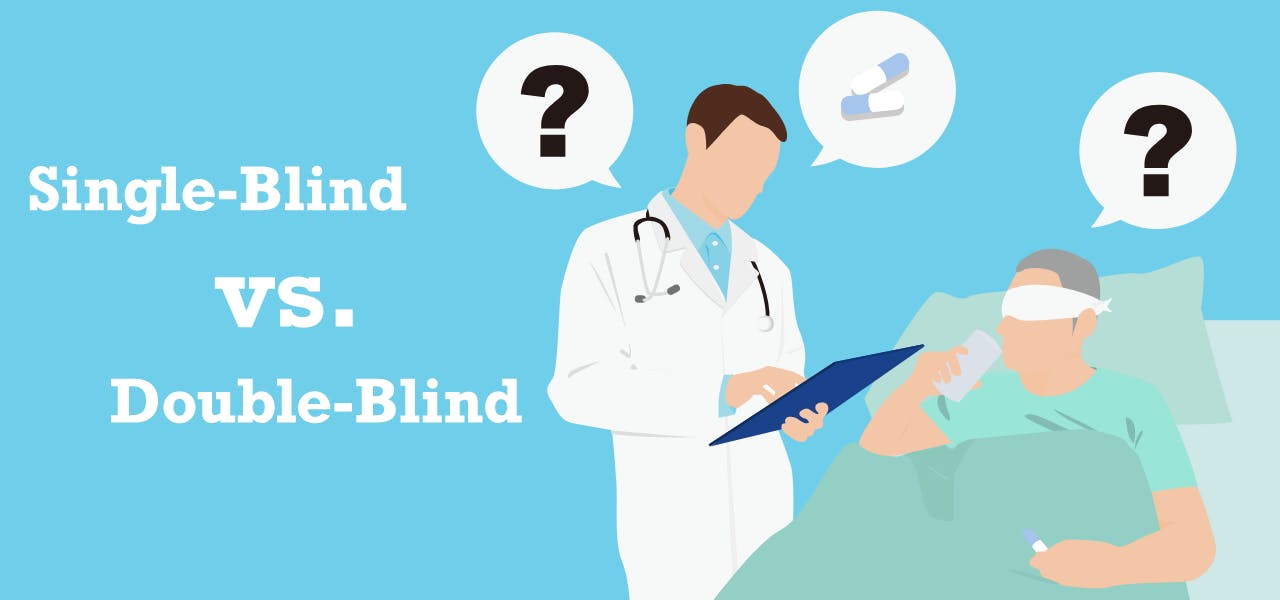Have you ever wondered how scientists ensure the accuracy and reliability of their research findings? A critical tool in their arsenal is the use of blinded studies.
But what exactly is blind studies, and what’s the difference between single and double-blind studies?
This article will explore the fascinating world of blinded studies and uncover the critical distinctions between these standard study designs. So buckle up and get ready to learn!

Table of contents
- What is a single-blind study?
- What is a double-blind study?
- What are some potential limitations of blinded studies?
- What factors might influence the decision to use a single-blind versus double-blind design?
- What measures can researchers take to maintain blinding throughout a study?
- What are the implications of unblinding in a research study?
- Frequently Asked Questions
- Conclusion
- References
- Recommendations
What is a single-blind study?
A single-blind study is a research design in which the participants are unaware of whether they are receiving the experimental treatment or a placebo, but the researchers conducting the study know who is receiving what.
In other words, the participants are “blinded” to the treatment condition, but the researchers are not. Single-blinding aims to reduce bias that may result from participants’ expectations or beliefs about the treatment they are receiving.
By withholding information about the treatment, researchers can avoid unintentional influence on participants’ behavior or assessments.
See also: What is Back to School Night? What Does Back to School Night Mean?
What is a double-blind study?
A double-blind study is a research design in which the participants and the researchers conducting the analysis are aware of who is receiving the experimental treatment or a placebo. In a double-blind study, the participants are “blind” to the treatment condition, and the researchers are also “blind” to which participants receive the treatment or placebo.
The purpose of double-blinding is to eliminate bias and increase the reliability of the results. By withholding information about the treatment from participants and researchers, researchers can avoid unintentional influence on participants’ behavior or assessments and prevent any intentional or accidental biases that may result from researchers’ expectations or beliefs about the treatment.
Difference Between single blind study and a double blind study?
| Single-blind study | Double-blind study | |
| Participants | Blinded to treatment | Blinded to treatment |
| Researchers | Not blinded | Blinded to treatment |
| Purpose | Reduce bias from participant expectations or beliefs about treatment | Eliminate bias from both participant expectations and researcher beliefs about treatment |
| Example scenario | Participants are given a medication and believe it to be the experimental drug, but some are actually given a placebo | Both participants and researchers are unaware of whether a patient is receiving a new drug or a placebo |
| Advantages | Can be easier to implement than double-blind studies | Provides stronger evidence against biases, more rigorous than single-blind studies |
| Limitations | Participants may not be equally blinded, can still have experimenter bias | May be more difficult to implement and can be more expensive than single-blind studies |
| Common in which fields? | Behavioral and social sciences, where there is a lower likelihood of confounding variables | Medical research, particularly clinical trials |
| Data analysis | Analysis of data may not be affected by the blinding | Analysis of data is not affected by the blinding, but requires additional care to maintain the blinding during data collection |
Have you read: What is The Difference Between a Catholic School and a Parochial School?
What are some potential limitations of blinded studies?
Blinded studies can have limitations such as:
Bias
Even with blinding, biases can still occur if researchers or participants become aware of the treatment group. This can happen if there is no intention for cues or if participants guess their group assignment.
Ethics
In some cases, blinding may not be ethical. For example, it may not be honest to blind participants to a placebo treatment if they have a life-threatening condition, and the placebo may be harmful.
Cost and feasibility
Blinded studies can be more costly and time-consuming compared to unblinded studies, as they require additional measures to maintain blinding throughout the study.
Generalizability
Blinded studies may not always reflect real-world scenarios, as participants may have different experiences when they know which group they are in than when they do not.
Participant dropout
Blinding can cause confusion or uncertainty among participants, which may lead to a higher dropout rate compared to unblinded studies.
External validity
Blinding can limit the generalizability of findings to specific populations or settings.
Overall, blind studies are essential for minimizing bias and improving the validity of study results.
The following questions will address examples of studies using a single-blind or double-blind design. These factors influence the decision to use a single-blind versus double-blind design and how to inform about their treatment condition.
Have you read: How Long is Vet School?
What factors might influence the decision to use a single-blind versus double-blind design?
The decision to use a single-blind or double-blind design depends on several factors, including:
- Risk of bias: If there is a high risk of bias, such as in drug trials or medical interventions, a double-blind design may be preferred to reduce the impact of subjective preferences.
- Participant and researcher expectations: If participants or researchers have strong expectations or beliefs about the treatment, this can influence the study results. In such cases, a double-blind design may be best to prevent bias.
- Feasibility: Double-blind studies can be more complex and expensive than single-blind studies. Therefore, the feasibility and resources available may influence the choice of design.
- Type of intervention: Certain interventions may make blinding difficult or impossible. For example, it may be impossible to blind participants to surgery or some behavioral interventions.
- Sample size: Studies with larger sample sizes may be more robust to potential bias and, therefore, may be more likely to use a single-blind design.
- Nature of the outcome measure: Some measures may be more objective and less likely for biases to influence it, making a single-blind design sufficient.
Ultimately, the choice between a single-blind or double-blind design will depend on carefully considering these and other factors specific to the research question and the study population.
See also: How Long is Barber School?
What measures can researchers take to maintain blinding throughout a study?
To ensure that blinding is maintained throughout a study, researchers can take several measures:
Use appropriate blinding methods.
Researchers should use appropriate methods to blind participants and researchers. For example, they may use placebos, sham procedures, or identical-looking interventions to prevent participants from guessing their group.
Monitor blinding
Researchers should monitor blinding throughout the study to ensure that participants and researchers are not unintentionally unblinded. This can be done through regular assessments or surveys to check if participants know about their group assignment.
You should read: Is Yale a Good School to Study Architecture?
Train study staff
Researchers should train study staff to avoid providing cues or information that could unblind participants. Study staff should also be made aware of the importance of maintaining blinding.
Randomize group assignment
Researchers should use randomization to assign participants to groups to minimize the risk of bias.
Mask data
Researchers should mask the data so that those analyzing the data are also blinded to group assignments.
Plan for unblinding
Researchers should plan for unblinding if necessary, such as in cases where participant safety is at risk. This should be done to minimize the risk of bias in the study.
Maintaining blinding throughout a study is essential to minimize bias and ensure the validity of the study results. By taking appropriate measures, researchers can reduce the risk of unblinding and increase the likelihood of obtaining reliable and valid results.
Have you read: What is Back to School Night? What Does Back to School Night Mean?
What are the implications of unblinding in a research study?
Unblinding in a research study can have several implications, including:
- Bias: Unblinding can introduce bias into the study. Participants or researchers who know their group may behave differently or interpret the results differently than those with blinds.
- Invalid results: Unblinding can compromise the validity of study results, as the actual effect of the intervention may be obscured by the influence of biases.
- Reduced statistical power: Unblinding can lead to a loss of statistical power, as the variability of the results may increase due to the influence of biases.
- Ethical concerns: Unblinding may raise ethical concerns if participants are unaware that they could become unblinded or were not fully informed about the potential risks and benefits of the study.
- Difficulty in interpreting results: Unblinding can make it challenging to interpret study results and draw conclusions, as it may need to be clarified to what extent the results are influenced by bias.
Unblinding can have severe implications for the validity of study results and the interpretation of those results. Therefore, researchers need to take appropriate measures to maintain blinding throughout the study and plan for unblinding only when necessary and in a way that minimizes the risk of bias.
Frequently Asked Questions
A single-blind study is a research design in which the participants are unaware of whether they receive the experimental treatment or a placebo. Still, the researchers conducting the study know who is receiving what.
A double-blind study is a research design in which the participants and researchers must be made aware of who gets the experimental treatment or a placebo. This helps to eliminate bias and increase the reliability of the results.
Blinding is important in research studies because it helps to reduce bias and increase the accuracy and reliability of the results. By withholding information about the treatment, researchers can avoid unintentional influence on participants’ behavior or assessments.
One potential drawback of blinding is that it can be challenging to ensure that all participants receive the same level of care and attention, regardless of whether they accept the experimental treatment or a placebo. Additionally, blinding can sometimes be challenging to implement or maintain, particularly in certain studies.
You can typically find information about whether a study was single-blind or double-blind in the methods section of the published article. If the study was double-blind, the authors should describe how to implement and verify the blinding.
Conclusion
The difference between a single-blind and a double-blind study lies in the level of information kept from participants and researchers. While both designs aim to reduce bias and increase the reliability of research findings, the double-blind approach provides an extra layer of protection against experimenter bias.
By understanding the nuances of these study designs, you can better evaluate the quality of scientific research and make informed decisions about the validity of the results. So remember, the next time you come across a research study, consider whether it was single-blind, double-blind, or not blinded at all – it could make all the difference!
References
- cancer. govtext– Blind study
- biopharmainstitute.com– Difference between single-blind and double-blind
- methods.sagepub.com– Difference between single-blind and double-blind




